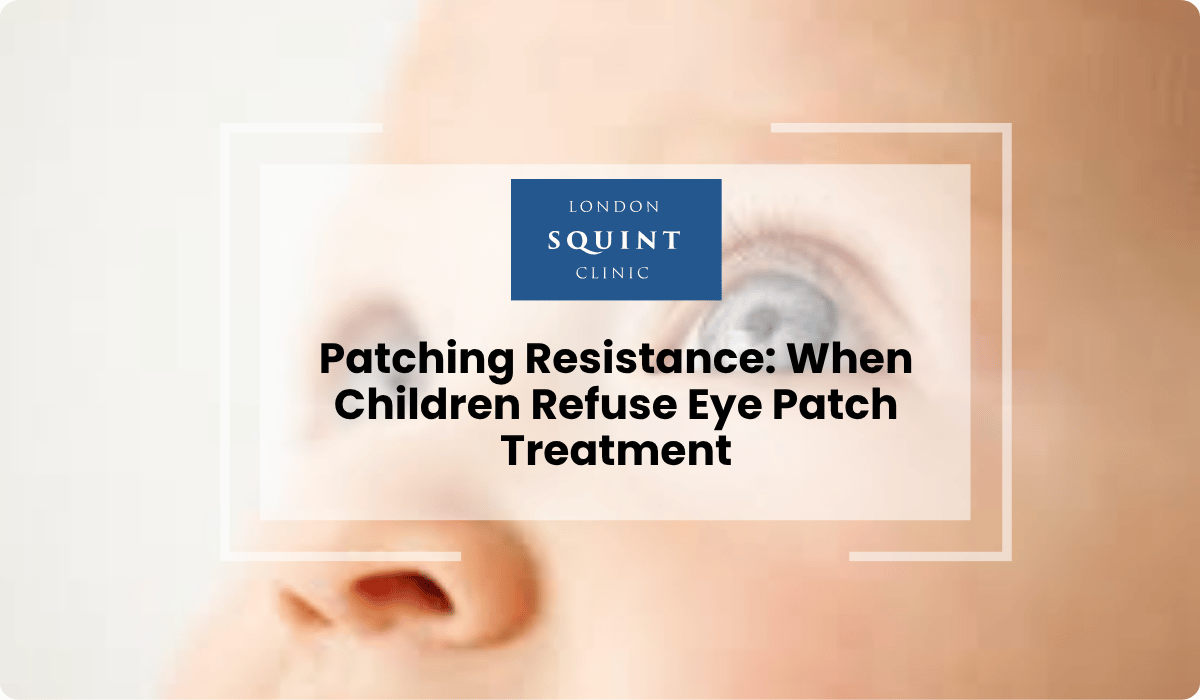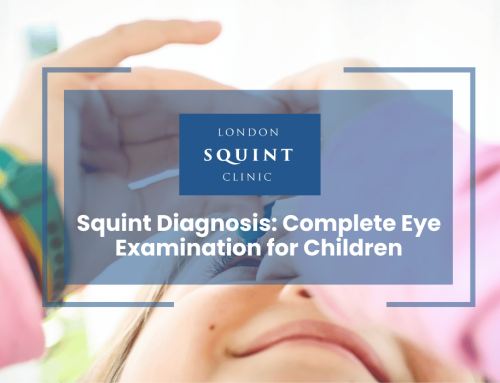Patching Resistance: When Children Refuse Eye Patch Treatment
Essential Insights for Parents Managing Eye Patching
- Understand the purpose: Patching treats amblyopia by forcing the brain to use the weaker eye, with the best results occurring during the critical visual development period (up to age 8-9).
- Recognize resistance: Children may resist patches due to physical discomfort, visual challenges, social concerns, and feelings of lost control.
- Implement age-appropriate strategies: Use distraction for toddlers, play-based approaches for preschoolers, ownership techniques for school-aged children, and negotiation with adolescents.
- Create positive associations: Establish consistent routines, use positive reinforcement, ensure physical comfort, and develop engaging “patch time” activities.
- Consider alternatives when needed: Atropine eye drops, optical penalization, binocular treatments, and vision therapy are evidence-based options when traditional patching fails.
- Consult professionals promptly: Speak with your pediatric ophthalmologist when facing persistent resistance, skin reactions, emotional distress, vision changes, or plateauing progress.
Table of Contents
- Understanding Amblyopia and Why Patching Is Essential
- Common Reasons Children Resist Wearing Eye Patches
- How to Recognize Signs of Patching Resistance
- Why Do Children Hate Eye Patches? The Psychology Explained
- Effective Strategies to Overcome Patching Difficulties
- Age-Appropriate Approaches to Improve Patch Compliance
- Alternative Treatment Options When Patching Fails
- When to Consult Your Pediatric Ophthalmologist
Understanding Amblyopia and Why Patching Is Essential
Amblyopia, commonly known as ‘lazy eye’, affects approximately 2-3% of children in the UK. This condition develops when the brain and one eye fail to work together properly, causing the brain to favour the stronger eye and gradually ignore visual signals from the weaker one. Without intervention, this can lead to permanent vision impairment in the affected eye.
Patching therapy (occlusion therapy) remains the gold standard treatment for amblyopia. The principle is straightforward yet highly effective: by covering the stronger eye with a patch, we force the brain to process visual information from the weaker eye, thereby strengthening its neural connections and improving vision. During the critical period of visual development (typically up to age 8-9), the brain maintains significant neuroplasticity, making this the optimal window for treatment.
Research consistently demonstrates that consistent patching during this critical period can improve visual acuity by several lines on the vision chart. The prescribed patching duration varies based on the severity of amblyopia, the child’s age, and their response to treatment—typically ranging from 2-6 hours daily. This treatment approach has stood the test of time because it addresses the fundamental neurological basis of amblyopia rather than merely treating symptoms.
Common Reasons Children Resist Wearing Eye Patches
Children resist eye patches for numerous understandable reasons. Physical discomfort ranks among the most common complaints—adhesive patches may irritate sensitive skin, causing redness, itching, or even mild allergic reactions. The patch edge can feel scratchy, and prolonged wearing may lead to sweating underneath, creating further irritation. This physical discomfort creates an immediate aversion that’s difficult for children to articulate beyond simply refusing to wear the patch.
Visual challenges present another significant barrier. When wearing a patch, children temporarily lose binocular vision and depth perception, making everyday activities like climbing stairs, playing with toys, or participating in sports suddenly more difficult. This functional limitation can be frustrating and even frightening, particularly for younger children who don’t fully understand why they must endure this difficulty.
Social concerns become increasingly prominent as children grow older. School-aged children may face teasing or unwanted attention from peers, leading to embarrassment and self-consciousness. Many children report feeling “different” or “strange” when wearing their patch in public settings. This social dimension often intensifies resistance, particularly during school hours or social gatherings where children are most concerned about peer perception.
Additionally, many children struggle with the lack of control they feel during treatment. Being told they must wear something they dislike, without fully understanding the long-term benefits, naturally triggers resistance—especially during developmental stages where autonomy becomes increasingly important.
How to Recognize Signs of Patching Resistance
Identifying patching resistance early allows for prompt intervention before the treatment regimen is completely derailed. The most obvious sign is direct verbal refusal—when a child clearly states “I won’t wear it” or “I hate the patch.” However, resistance often manifests in more subtle ways that parents should vigilantly monitor.
Physical avoidance behaviours are common indicators. Children may repeatedly remove the patch when unsupervised, sometimes within minutes of application. Some children develop remarkable dexterity in quickly peeling off patches without parents noticing. Others might negotiate constantly for “just five more minutes” before putting on the patch, or create elaborate distractions when patching time approaches.
Emotional signs of resistance include increased irritability specifically around patching time, sudden tearfulness when the patch is mentioned, or expressions of anxiety before patching sessions. Some children develop somatic complaints—reporting headaches, eye pain, or nausea—that conveniently coincide with scheduled patching times but resolve when patching is postponed.
Behavioural changes may also signal resistance. A normally cooperative child might become defiant specifically around patching. Some children begin hiding patches, “losing” them repeatedly, or damaging them intentionally. Parents might notice a pattern of increased behavioural issues during patched periods as children struggle with the visual limitations and discomfort.
Monitoring compliance becomes increasingly challenging as children spend time in different environments (school, childcare, with other family members). Inconsistent reports about patching compliance from different caregivers often indicates resistance occurring outside parental supervision.
Why Do Children Hate Eye Patches? The Psychology Explained
The psychological underpinnings of patch resistance are complex and developmentally nuanced. For toddlers and preschoolers, the primary issue revolves around immediate sensory experience—they simply cannot reconcile the immediate discomfort with abstract future benefits. Their developmental stage prioritises present experience over future outcomes, making the daily struggle particularly challenging.
For school-aged children, identity and social belonging become paramount concerns. The patch creates a visible difference at precisely the developmental stage when fitting in with peers takes on heightened importance. Research in developmental psychology demonstrates that children aged 6-12 become increasingly aware of social comparison and potential stigmatisation. The patch becomes not just a medical device but a symbol that marks them as “different” during a period when sameness provides psychological security.
Control and autonomy also play crucial roles in patching resistance. Children naturally seek increasing independence as they develop, and the prescribed patching regimen can feel like an unwelcome intrusion on their growing sense of bodily autonomy. This is particularly evident in children around ages 3-5 (during the “autonomy vs. shame and doubt” stage described by developmental psychologists) and again during pre-adolescence when independence becomes a central developmental task.
Additionally, children may develop anticipatory anxiety about patching. If early experiences with the patch were particularly negative or if they associate patching with other unpleasant medical experiences, a conditioned anxiety response can develop. This psychological association can trigger resistance even before the patch is applied, creating a challenging cycle to break.
Effective Strategies to Overcome Patching Difficulties
Establishing a consistent routine forms the foundation of successful patching. Children thrive on predictability, so integrating patching into the daily schedule at the same time each day helps normalise the experience. Many families find success with a visual schedule or patching calendar where children can track their progress, creating a sense of accomplishment and making the abstract concept of treatment more concrete.
Positive reinforcement significantly improves compliance. Small, immediate rewards for successful patching periods work particularly well with younger children. This might include sticker charts, special activities reserved for patching time, or earned privileges. For older children, a points-based system working toward larger rewards can maintain motivation over the longer treatment course. Importantly, rewards should focus on compliance rather than lack of complaints—rewarding the behaviour you want to encourage.
Addressing physical comfort directly improves the patching experience. Hypoallergenic patches designed specifically for sensitive skin can reduce irritation. Some families find success with non-adhesive patch alternatives that attach to glasses frames instead of skin. Applying a thin layer of non-irritating barrier cream around (not under) the patch area can prevent skin irritation while maintaining adhesion. For children who experience excessive sweating, scheduling patching during lower-activity periods and ensuring regular breaks for skin to “breathe” can help.
Creating engaging “patch time” activities transforms the experience from punishment to special opportunity. Vision therapy exercises specifically designed to strengthen the weaker eye can be incorporated as games. Activities requiring detailed close vision—like building with small blocks, threading beads, or specific drawing exercises—provide both entertainment and therapeutic benefit by challenging the patched eye.
Involving children in treatment decisions wherever possible increases their sense of control. Even simple choices—selecting patch designs, choosing which activities to do during patching time, or deciding where in the home patching will occur—can significantly reduce resistance by addressing the underlying need for autonomy.
Age-Appropriate Approaches to Improve Patch Compliance
For infants and toddlers (0-2 years), distraction serves as the primary strategy. During this developmental stage, children have limited understanding of treatment rationale but are highly distractible. Introducing novel toys specifically reserved for patching time, engaging in animated play, or incorporating favourite activities can redirect attention away from the patch. Physical comfort is paramount—using hypoallergenic patches designed for sensitive skin and scheduling patching during alert but calm periods improves tolerance. Parents should maintain a matter-of-fact attitude during application, avoiding telegraphing anxiety or hesitation which young children readily detect.
Preschoolers (3-5 years) benefit from concrete explanations and play-based approaches. Simple, age-appropriate explanations using analogies help build understanding—comparing the eye to a muscle that needs exercise works well. Incorporating patching into imaginative play transforms the experience; children might patch stuffed animals alongside themselves or pretend to be pirates during patch time. Establishing consistent routines with visual timers helps preschoolers understand the duration. This age group responds particularly well to immediate positive reinforcement through sticker charts or small rewards for compliance.
School-aged children (6-12 years) require more sophisticated approaches focusing on understanding and ownership. Detailed, age-appropriate explanations of amblyopia using diagrams or videos help children comprehend the purpose of treatment. Involving them in tracking their own visual progress through simple vision games creates investment in outcomes. Social concerns become prominent at this age—decorative patches, scheduling patching for home hours, or creating classroom education about eye conditions (with the child’s permission) can address potential stigma. Responsibility-based approaches work well; children might set their own timers, record their patching hours, or earn privileges based on self-management of their treatment.
Adolescents present unique challenges as peer perception becomes paramount. Transparent communication about treatment goals, including specific visual acuity targets and timeframes, respects their cognitive development. Negotiating patching schedules that accommodate social activities while maintaining therapeutic effectiveness demonstrates respect for their priorities. Technology-based compliance tools, including apps that track patching time or gamify treatment, often appeal to this age group. Connecting teens with peers who have successfully completed patching can provide powerful motivation and reduce feelings of isolation.
Alternative Treatment Options When Patching Fails
When traditional patching proves consistently unsuccessful despite best efforts, several evidence-based alternatives can effectively treat amblyopia. Atropine eye drops represent one of the most well-established alternatives. This pharmacological approach involves applying dilating drops to the stronger eye, which temporarily blurs vision and forces reliance on the weaker eye. Research, including the landmark Pediatric Eye Disease Investigator Group (PEDIG) studies, demonstrates that daily atropine can be equally effective as patching for moderate amblyopia while often achieving better compliance. The drops are typically administered once daily, making them less intrusive than hours of patching, though they may cause light sensitivity and temporary difficulty with near vision.
Optical penalisation offers another non-patching approach. This method involves prescribing glasses with a lens that deliberately blurs the stronger eye (through fogging, filters, or specific lens designs) while correctly prescribing for the weaker eye. This creates a similar effect to patching but without the visible patch. Bangerter filters—translucent filters applied to spectacle lenses—provide variable degrees of penalisation that can be adjusted as treatment progresses.
Binocular treatments represent an emerging alternative focusing on training both eyes to work together rather than penalising the stronger eye. These include specialized computer games and virtual reality applications designed to present different elements of the same image to each eye, forcing binocular cooperation. Early research suggests these approaches may improve both visual acuity and binocular function, potentially addressing deeper aspects of amblyopia than traditional methods.
Vision therapy programmes delivered by orthoptists or specialised optometrists provide structured visual exercises designed to improve visual processing. These typically combine in-office sessions with home exercises, focusing on visual discrimination, eye tracking, and binocular coordination. While requiring significant commitment, these programmes can be particularly effective for complex cases with both amblyopia and binocular vision dysfunction.
In cases where significant refractive errors contribute to amblyopia, sometimes simply maintaining consistent wear of properly prescribed glasses can gradually improve vision over time, particularly in younger children with moderate amblyopia.
When to Consult Your Pediatric Ophthalmologist
Persistent patching resistance warrants prompt consultation with your pediatric ophthalmologist, particularly when compliance falls below 50% of prescribed hours for more than two consecutive weeks. This pattern suggests that the current approach requires modification before treatment efficacy is compromised. Similarly, if your child develops skin reactions including persistent redness, rashes, or breaks in the skin around the patch area, professional guidance is needed to address these complications while maintaining treatment momentum.
Significant emotional distress surrounding patching necessitates clinical review. While some resistance is expected, extreme responses such as consistent tearfulness, sleep disturbances, or school avoidance indicate that the psychological burden may outweigh therapeutic benefits in the current format. Your ophthalmologist can help balance visual outcomes with emotional wellbeing through modified approaches.
Regular follow-up appointments are essential regardless of compliance levels, typically scheduled every 2-3 months during active amblyopia treatment. However, if you notice any changes in your child’s vision—such as increased squinting, head tilting, eye rubbing, or complaints about vision in either eye—an earlier appointment is warranted. These symptoms could indicate changing visual status requiring treatment adjustments.
When considering alternative treatments, professional guidance is crucial. Rather than independently abandoning patching, discuss your specific challenges with your ophthalmologist who can recommend evidence-based alternatives appropriate for your child’s particular condition, age, and circumstances. They can provide realistic expectations about alternative approaches and help transition between treatment modalities while maintaining therapeutic momentum.
Finally, consult your ophthalmologist if you observe plateauing progress despite good compliance. If visual acuity remains unchanged across two consecutive visits despite adherence to the prescribed regimen, treatment parameters may need adjustment. This could involve increasing patching hours, combining approaches, or investigating additional factors affecting treatment response.
Frequently Asked Questions
How long does my child need to wear an eye patch each day?
The daily patching duration varies based on amblyopia severity, typically ranging from 2-6 hours. Moderate amblyopia usually requires 2-4 hours daily, while severe cases may need 4-6 hours. Your pediatric ophthalmologist will prescribe specific hours based on your child’s condition and adjust this schedule during follow-up appointments based on treatment response.
At what age is patching no longer effective for amblyopia?
Patching is most effective during the critical period of visual development, typically up to age 8-9 years. However, recent research shows some children may respond to treatment up to age 12-14, though with diminishing returns. The brain’s neuroplasticity decreases with age, making early intervention ideal but not eliminating the possibility of improvement in older children.
Can my child wear the patch during school hours?
While technically possible, many ophthalmologists recommend scheduling patching during home hours, especially for school-aged children. Patching at school can create learning challenges due to reduced vision and potential social concerns. If school patching is necessary due to prescribed duration, collaborate with teachers to ensure appropriate accommodations and consider educating classmates about the treatment to reduce stigma.
What should I do if my child’s skin becomes irritated from the patch?
For skin irritation, try hypoallergenic patches specifically designed for sensitive skin, apply a thin barrier cream around (not under) the patch area, and ensure the skin is completely dry before application. Allow “patch-free” days occasionally if irritation is severe. Consider non-adhesive alternatives like patches that attach to glasses frames. Consult your ophthalmologist if irritation persists, as they may recommend alternative treatment approaches.
How do I know if the patching treatment is working?
Successful patching treatment is measured primarily through improved visual acuity in the weaker eye, which your ophthalmologist will assess during regular follow-up appointments (typically every 2-3 months). At home, you might notice improved depth perception, less squinting or head tilting, and better eye coordination during activities requiring visual focus. Improvement is usually gradual, with significant changes often taking several months of consistent patching.
Can amblyopia return after successful treatment?
Yes, amblyopia can recur, particularly if treatment is stopped abruptly before the child reaches visual maturity (around age 10-12). The risk of recurrence is highest in the first year after treatment cessation. Most ophthalmologists recommend a gradual tapering of patching hours rather than sudden discontinuation, followed by periodic monitoring until visual development is complete. Maintaining proper glasses wear (if prescribed) is also crucial in preventing recurrence.
What happens if we can’t achieve consistent patching despite our best efforts?
If consistent patching proves impossible despite multiple strategies, don’t despair. Alternative treatments include atropine eye drops (which blur the stronger eye), optical penalization through specialized glasses, binocular treatments using computer games or VR applications, and structured vision therapy programs. Discuss these options with your ophthalmologist, who can recommend the most appropriate alternative based on your child’s specific condition, age, and circumstances.
Find out if you are suitable for Double Vision Treatment
Not everyone is eligible for double vision surgery.
Find out if you could benefit from this life-changing surgery by taking the quick self-suitability quiz below:
Our most popular procedures

Hello, I’m Nadeem Ali
I’m one of the few eye surgeons in the world with 100% focus on Squint and Double Vision Surgery.
I have 24 years of eye surgery experience, and worked for 13 years as a Consultant at London’s renowned Moorfields Eye Hospital.
In 2023, I left the NHS to focus fully on treating patients from across the world at the London Squint Clinic. You can read more about me here.
There’s lots of information on the website about: squint surgery, double vision surgery and our pricing.
The most rewarding part of my job is hearing patients tell me how squint or double vision surgery has changed their lives. You can hear these stories here.
Mr Nadeem Ali
MA MB BChir MRCOphth FRCSEd(Ophth)





